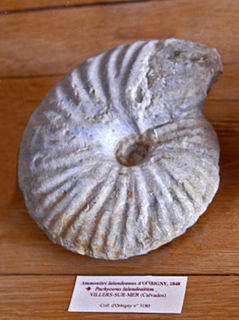
The Aalenian is a subdivision of the Middle Jurassic Epoch/Series of the geologic timescale that extends from about 174.1 Ma to about 170.3 Ma. It was preceded by the Toarcian and succeeded by the Bajocian.

Aulacostephanus is an extinct ammonoid cephalopod genus from the Upper Jurassic Tithonian belonging to the perisphinctacean family Aulacostephanidae.
Apoderoceras is an extinct genus of cephalopod belonging to the Ammonite subclass.
Eudmetoceras is an extinct genus from a well-known class of fossil cephalopods, the ammonites. It lived during the Jurassic Period, which lasted from 171.6 to 168.4 million years ago.
Procerites is an extinct genus from a well-known class of fossil cephalopods, the ammonites. It lived during the Jurassic Period.
Otoites is the type genus of the ammonite family Otoitidae that live during the Middle Jurassic.

Oppelia is a haploceratoid ammonite and type genus for the Oppeliidae that lived during the Middle Jurassic. Shells of Oppelia are involute with a small to moderate size umbilicus, bluntly rounded to sharp venter, and deeply impressed dorsum. Sides are generally smooth but may be variously ribbed on the outer flanks. Similar and related genera include Oxycerites and Oecotraustes.

Hyperlioceras is an extinct genus of cephalopod included in the ammonitid family Graphoceratidae that lived during the Bajocian stage of the Middle Jurassic. The type species is Hyperlioceras discites

Archaeonectrus is an extinct genus of pliosaur from the Early Jurassic (Sinemurian) of what is now southeastern England. The type species is Archaeonectrusrostratus, first named by Sir Richard Owen in 1865, which was moved to its own genus by N.I. Novozhilov in 1964.

Hulettia is an extinct genus of prehistoric bony fish found in the Morrison Formation in the western United States, measuring approximately three to four inches in length. This fish genus contains one species, H. americana. Its body was covered in thick prominent scales, and its name is based on Hulett, Wyoming, a locale which is near the Morrison Formation. Discovered specimens show evidence of predation upon the smaller species of fish Todiltia that inhabited the Jurassic Lake Todilto, and another specimen discovered in the Bathonian coastal sandstone, in the Sundance Formation of South Dakota. Both specimens are complete skeletons with no fragmentary remains or dubious anomalies amongst the bones recovered.

Psiloceras is an extinct genus of ammonite. Psiloceras is among the earliest known Jurassic ammonites, and the appearance of the earliest Psiloceras species form the definition for the base of the Jurassic. Unlike most earlier ammonites, which had complex shell shapes and ornamentation, Psiloceras had a smooth shell.

Phylloceras is an extinct genus of ammonoid cephalopods belonging to the family Phylloceratidae. These nektonic carnivores lived from Early Jurassic to Late Cretaceous.
Eoderoceras is an evolute, round whorled ammonite from the Lower Jurassic with an outer row of distinct spines, and in some, an inner row of tubercles, on either side; ribs only on the inner whorls.

Orthosphinctes is a genus of ammonites belonging to the order Ammonitida family Ataxioceratidae.

Belemnites is a genus of an extinct group of cephalopods belonging to the order Belemnitida. These cephalopods existed in the Early Jurassic period from the Hettangian age to the Toarcian age (175.6–183.0). They were fast-moving nektonic carnivores.

Pachyceras is a genus of perisphinctoid ammonites from the Middle Jurassic, upper Callovian stage, and is the type genus for the family Pachyceratidae. The shell is involute, subglobular, with a deep umbilicus and flattened flanks that slope toward a more narrowly rounded venter, and covered by low, widely spaced ribs.

Lytoceratinae is a subfamily of ammonoid cephalopods that make up part of the family Lytoceratidae.

Pterotrigonia is an extinct genus of saltwater clams, marine bivalve molluscs in the family Megatrigoniidae. This genus is known in the fossil record from the Jurassic period Tithonian age to the Cretaceous period Maastrichtian age. Species in this genus were facultatively mobile infaunal suspension feeders. The type species of the genus is Pterotrigonia cristata.

Parkinsonia is a genus of ammonites belonging to the family Parkinsoniidae.
Reynesoceras is genus of ammonites that lived during the upper Pliensbachian stage of early Jurassic. It has evolved from Prodactylioceras, or Cetonoceras. Dactylioceras (Eodactylites) has probably evolved from this genus. Aveyroniceras is a name for macroconchs of this genus. Their fossils were found in Europe, northern Africa, Asia, North America and South America.














